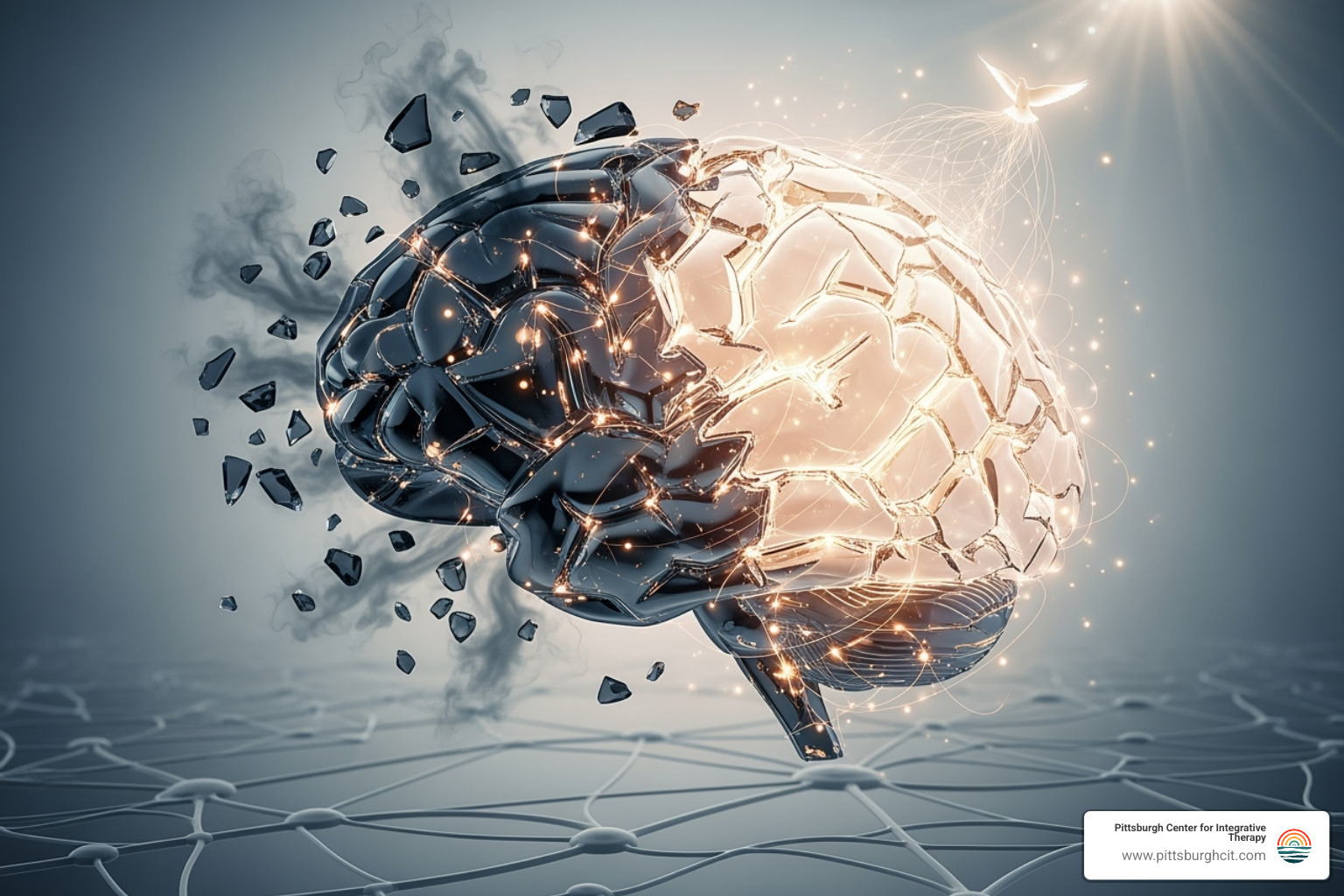EMDR Therapy for Trauma in Murraysville, PA: Unlocking Your Brain's Natural Healing Power
Understanding EMDR: Your Path to Healing from Trauma

EMDR treatment for trauma is a powerful, evidence-based therapy designed to help your brain naturally process and heal from traumatic experiences. If you feel stuck by past events, struggling with anxiety, or disconnected from others, EMDR offers a unique path forward. Unlike traditional talk therapy, it doesn't require you to relive painful memories in detail. Instead, it uses bilateral stimulation (like eye movements) to help your brain reprocess stuck memories and reduce their emotional impact.
Quick Overview: What You Need to Know About EMDR
- What it is: Eye Movement Desensitization and Reprocessing, a structured therapy using bilateral stimulation.
- How it works: Helps your brain reprocess traumatic memories so they are less emotionally charged.
- Who it helps: Adults, teens, children, couples, and families dealing with trauma, PTSD, and anxiety.
- Key benefit: Doesn't require detailed discussion of traumatic events, which can feel re-traumatizing.
Your brain has an incredible natural ability to heal. EMDR therapy works by removing the "blocks" that can get in the way of this process, much like clearing debris from a wound allows it to heal properly. At Pittsburgh Center for Integrative Therapy, our EMDRIA-certified therapists have witnessed how this approach can transform lives by helping clients process stress responses trapped in their nervous system, restoring feelings of safety and connection.
What is EMDR? A Closer Look at This Groundbreaking Trauma Therapy

Eye Movement Desensitization and Reprocessing (EMDR) is a highly effective therapy that has changed how we understand healing from trauma. It began in 1987 when Dr. Francine Shapiro finded that her own disturbing thoughts became less intense when her eyes moved rapidly back and forth. This observation led to years of research and the development of a powerful, structured treatment.
EMDR treatment for trauma is not about erasing memories. Instead, it changes how traumatic memories are stored in your brain, reducing their emotional distress. Think of it like reorganizing a messy filing cabinet—the files are still there, but they are stored in a way that no longer causes chaos. At Pittsburgh Center for Integrative Therapy, we provide personalized care that is customized to your specific needs and healing goals.
The Science Behind Healing: The Adaptive Information Processing (AIP) Model
The Adaptive Information Processing (AIP) model is the scientific foundation of EMDR. It suggests that your brain has a natural system for processing and filing away daily experiences. When something traumatic happens, this system can get overwhelmed, and the memory becomes "stuck"—frozen in time with all its original intensity, emotions, and physical sensations. This is why triggers can make you feel like the trauma is happening all over again.
EMDR helps restart this natural processing system. It allows your brain to "unstick" these frozen memories so they can be filed away properly as past events, not current threats. You can learn more about our comprehensive approach at our EMDR therapy services page.
How EMDR Differs from Traditional Talk Therapy
While talk therapy is valuable, EMDR offers a different approach that can be particularly effective for trauma. The key differences include:
- Focus on Processing, Not Talking: EMDR prioritizes your brain's internal processing over detailed verbal accounts of the trauma. This can be a relief for those who find it difficult or re-traumatizing to talk about painful events.
- Body-Based (Somatic) Component: Trauma is stored in the body, not just the mind. EMDR directly addresses the physical symptoms and tension associated with traumatic memories.
- No Homework: The processing happens within the session, so there are no homework assignments or exercises to complete between appointments.
- Efficient Results: By directly targeting how traumatic memories are stored, EMDR can often lead to significant, lasting change in a shorter timeframe than many traditional therapies.
The 8 Phases of EMDR: A Structured Path to Healing

One of the most reassuring aspects of EMDR treatment for trauma is its structured, eight-phase protocol. This framework ensures your journey is both safe and effective, with each phase building on the last. At Pittsburgh Center for Integrative Therapy, our therapists customize this protocol to fit your individual needs, creating a collaborative and personalized path toward healing.
Phase 1-3: Building a Foundation for Safety and Processing
The first three phases are essential for creating a solid foundation. This is where you and your therapist build a strong therapeutic relationship and prepare for the deeper work ahead.
- Phase 1: History-Taking & Treatment Planning: Your therapist learns about your background and collaborates with you to create a roadmap for healing, identifying specific memories or "targets" for processing.
- Phase 2: Preparation: You learn crucial coping skills and relaxation techniques to support you throughout therapy. A key tool is developing a "safe place"—a mental sanctuary for calm and grounding.
- Phase 3: Assessment: You and your therapist will activate a specific target memory, identifying the associated negative belief (e.g., "I am not safe") and measuring its current disturbance level using standardized scales.
Phase 4-6: The Core Reprocessing Work
This is where the brain's natural healing process is activated to reprocess stuck memories and transform them from sources of pain into integrated parts of your life story.
- Phase 4: Desensitization: While holding the target memory in mind, you'll engage in bilateral stimulation (e.g., eye movements). This helps your brain process the memory, reducing its emotional charge until it no longer feels disturbing.
- Phase 5: Installation: Once the disturbance is gone, you'll focus on strengthening a positive, adaptive belief about yourself (e.g., "I am safe now").
- Phase 6: Body Scan: Because trauma is held in the body, this phase involves scanning for any lingering physical tension related to the memory and using bilateral stimulation to release it.
Phase 7-8: Integration and Future Pacing
The final phases ensure your healing is integrated into your daily life and prepares you for the future.
- Phase 7: Closure: At the end of every session, your therapist ensures you feel calm and stable before you leave, using the coping skills learned in Phase 2.
- Phase 8: Re-evaluation: At the beginning of each new session, you'll check on previously processed memories to ensure the healing is holding. This phase also helps identify any new targets and prepares you for future challenges.
For more information on our approach, please visit our page on trauma therapy.
How Does the EMDR Treatment for Trauma Actually Work?

What makes EMDR treatment for trauma so effective lies in a process called Dual Attention Stimulation. This means you pay attention to two things at once: the traumatic memory and a form of bilateral stimulation (BLS). While eye movements are common, therapists at Pittsburgh Center for Integrative Therapy may also use auditory tones through headphones or gentle tapping on your hands or knees, customizing the approach to what works best for you.
The Role of Bilateral Stimulation in Reprocessing
Bilateral Stimulation is the engine of EMDR. The rhythmic, left-right stimulation is thought to work similarly to the way your brain processes experiences during REM sleep. By engaging both sides of your brain, BLS helps the different parts of your brain communicate more effectively.
This process is key because trauma can create a disconnect between the logical, thinking part of your brain and the emotional, survival-focused areas. BLS helps bridge this gap. It also taxes your working memory, which has the fascinating effect of making the traumatic memory less vivid and emotionally intense. This allows your brain to make new, healthier associations with the memory, integrating information like your current safety and strength.
How EMDR Changes the Brain's Response to Trauma
The changes that happen in your brain during EMDR treatment for trauma are profound. When trauma is unprocessed, the brain's alarm system (the amygdala) becomes hyperactive, and the memory-organizing center (the hippocampus) struggles to file the event as something that happened in the past.
EMDR helps these brain regions work together again. The amygdala learns to calm down because the threat is over, and the hippocampus can properly store the memory as a past event. This allows your brain's logical center (the prefrontal cortex) to integrate the memory with your current understanding of safety and resilience. The memory becomes part of your story, but it no longer controls your life. This neurobiological shift is what creates deep and lasting healing.
For a concise overview of the wider body of research on EMDR, you can explore the Wikipedia article on Eye Movement Desensitization and Reprocessing.
Who Can Benefit and What Conditions Can EMDR Treat?

One of the most powerful aspects of EMDR treatment for trauma is its versatility. It can be adapted to meet people exactly where they are in their healing journey. At Pittsburgh Center for Integrative Therapy, our group practice has seen EMDR provide profound relief for adults, teens, children, couples, and families from all backgrounds. The therapy works with the brain's natural healing mechanisms, which are universal.
Using EMDR Treatment for Trauma and PTSD
Trauma exists on a broad spectrum. EMDR is effective for both "Big T" and "little t" traumas.
"Big T" Trauma refers to significant, life-threatening events like combat experiences, serious accidents, physical or sexual assault, and sudden loss. These events often lead to clear symptoms of Post-Traumatic Stress Disorder (PTSD).
"little t" trauma includes experiences that may seem less dramatic but are deeply impactful, especially when they are repetitive. Examples include chronic bullying, emotional neglect, or harsh criticism from caregivers. These can create lasting patterns of anxiety, depression, and relationship difficulties.
Our team at Pittsburgh Center for Integrative Therapy specializes in both single-incident trauma and complex trauma (C-PTSD), which often develops from prolonged or repeated traumatic experiences. We are experienced in helping first responders, veterans, and survivors of abuse reclaim their sense of safety and power.
Beyond PTSD: Other Applications for EMDR
While renowned for treating PTSD, EMDR's ability to process distressing memories makes it highly effective for a range of other conditions. Many of our current struggles have roots in past experiences that were never properly integrated. Our group practice regularly uses EMDR to address:
- Anxiety Disorders and Phobias: EMDR can reprocess the past experiences that fuel generalized anxiety, panic attacks, social anxiety, or specific phobias.
- Depression: When depression is linked to past events or internalized negative beliefs (e.g., "I'm not good enough"), EMDR can help process the root experiences and transform those beliefs.
- Complicated Grief: For those who feel "stuck" in their grief, EMDR can help process the traumatic aspects of a loss, allowing for a healthier way to carry the memory of a loved one.
- Chronic Pain: When pain has a psychological or unprocessed somatic component, EMDR can sometimes provide significant relief by addressing the underlying trauma.
- Performance Anxiety and Self-Esteem Issues: EMDR can help process past failures, criticism, or embarrassing moments that contribute to creative blocks, public speaking fears, and low self-worth.
The Effectiveness and Unique Advantages of EMDR Therapy

When considering EMDR treatment for trauma, it's natural to wonder if it really works. The answer is a resounding yes. EMDR is an evidence-based practice with decades of research backing its effectiveness. It is endorsed by major health organizations worldwide, including the American Psychiatric Association and the World Health Organization.
What the Research Says About EMDR's Success Rates
More than 30 controlled outcome studies have demonstrated EMDR's effectiveness for emotional trauma and other adverse life experiences. Research has consistently shown that EMDR can provide significant relief, often more rapidly than traditional trauma-focused therapies. Studies on single-trauma victims, multiple-trauma victims, and combat veterans have all found high rates of success, with a large percentage of participants no longer meeting the criteria for PTSD after treatment.
Key Advantages of EMDR Treatment for Trauma
Beyond its proven effectiveness, EMDR offers several unique advantages that make it a preferred option for many trauma survivors.
- It's a Gentler Approach: EMDR does not require prolonged exposure or detailed, repeated descriptions of the traumatic event. This use of brief, interrupted exposures reduces the risk of re-traumatization during therapy.
- It Focuses on Innate Healing: The therapy trusts and facilitates your brain's natural capacity to heal. The therapist acts as a guide, but your own brain does the work.
- It Can Be a Shorter Treatment: While every journey is unique, EMDR is often a time-limited therapy. Many people find significant relief in 6-12 sessions.
- Intensive Options are Available: At Pittsburgh Center for Integrative Therapy, we offer EMDR Intensives. These extended sessions allow for deeper, more focused processing in a condensed timeframe, which can be a fast track to healing. Learn more about EMDR intensives.
Frequently Asked Questions About EMDR Treatment for Trauma
We understand that starting any new therapy can bring up questions. At Pittsburgh Center for Integrative Therapy, we believe in providing clear, honest answers. Here are some of the most common questions we hear about EMDR treatment for trauma.
How long does EMDR therapy take?
The timeline for EMDR is unique to each individual, which is why we create personalized treatment plans. For a single-incident trauma, some people find relief in as few as 3-6 sessions. Complex or developmental trauma typically requires more time, often 12 sessions or more, to address multiple layers of experience. Our EMDR Intensives can also accelerate this process, allowing for more progress in a shorter period.
Is EMDR safe?
Yes, EMDR is considered very safe when conducted by a properly trained and certified therapist. The initial preparation phase is crucial, as we ensure you have strong coping skills before processing any memories. While it's possible to experience a temporary increase in emotion or new insights between sessions, this is a normal part of the healing process. Our therapists use specific techniques to ensure you feel stable and grounded at the end of every session.
Is EMDR covered by insurance for trauma treatment?
As a recognized, evidence-based psychotherapy, standard 50-minute EMDR sessions are often covered by insurance plans, just like any other form of therapy. Specialized formats like EMDR Intensives, which involve extended session times, are typically self-pay. The team at Pittsburgh Center for Integrative Therapy can help you understand your benefits and provide documentation for potential out-of-network reimbursement. We encourage you to reach out to discuss all financial aspects upfront.
Begin Your Healing Journey with EMDR in Murrysville, PA
If you're reading this, you've already taken a courageous step toward recovery. Healing from trauma is absolutely possible, and EMDR treatment for trauma offers an effective, efficient, and empowering path to reclaim your life.
At Pittsburgh Center for Integrative Therapy, we are dedicated to an integrative, client-centered approach. We honor your unique story and work collaboratively to create a personalized treatment plan that feels right for you. Our group practice specializes in a range of trauma-informed modalities to find what works best for your situation, including:
- EMDR
- EMDR Intensives
- Somatics
- Emotionally Focused Therapy (EFT)
- Internal Family Systems (IFS)
- Cognitive Processing Therapy (CPT)
Our experienced therapists work with adults, couples, families, teens, and children dealing with PTSD, trauma, anxiety, and depression. Conveniently located in Murrysville, PA, we are proud to serve the greater Pittsburgh area.
A path to peace and resilience awaits. Imagine feeling present and engaged with the people you love, free from the weight of the past. This is the reality that EMDR therapy can help you achieve.
Take the first step today. Your healing journey begins with the decision to reach out. Our team is ready to answer your questions and help you understand how EMDR can fit into your recovery. We also offer professional consultation, supervision, and education in EMDR for other mental health professionals.
